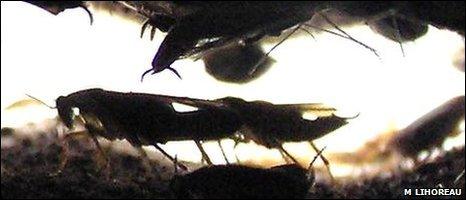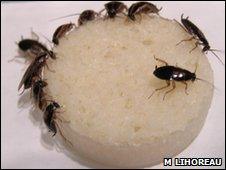How cockroaches 'talk' about food
- Published

An unpleasant sight in any kitchen
Cockroaches "recommend" good food sources to each other by communicating in chemicals, according to scientists.
The much-maligned insects appear to make a collective decision about the best food source.
The study, carried out by a team from Queen Mary, University of London, helps explain why the creatures are often found feeding en masse in our kitchens late at night.
It was published in the journal Behavioural Ecology and Sociobiology.
Dr Mathieu Lihoreau from Queen Mary's School of Biological and Chemical Sciences led the research. He pointed out that people tend to "kill cockroaches rather than study them".
"I can understand that," he told BBC News. "But it means we don't know very much about their behaviour."
It was generally accepted that the insects foraged individually, "but that's definitely not true," said Dr Lihoreau. "Anyone who has cockroaches in their home will tell you that's wrong - you see them in groups."
To test his suspicion that the creatures were in fact communicating with each other, he and his colleagues gave a group of cockroaches a food choice test.
"We released them into a small arena where there were two identical food sources," he explained. "If they didn't communicate, we would expect that they should just distribute on the two food sources equally."
But the majority of the hungry cockroaches (Blattella germanica) fed solely on one piece of food until it was all gone.
By following individual insects, it also emerged that the more of cockroaches there were on one piece of food, the longer each one would stay to feed.

The hungry insects appear to make a collective decision about what to eat
"We don't know how they communicate, but we know they're using chemicals," Dr Lihoreau explained. "That will be the next step - to find the chemicals involved in the communication.
"These observations coupled with simulations of a mathematical model indicate that cockroaches communicate through close contact when they are already on the food source."
He believes that the insects signal to each other using a "foraging pheromone" - possibly a chemical in their saliva or a hydrocarbon on their bodies.
"We think they encounter another cockroach, touch it and say 'ok, that's another cockroach, its eating good food, I'll stay'," he said.
Once identified, a man-made foraging pheromone could be used to improve pest control, making insecticide gels more effective or be used to create an insecticide-free trap.